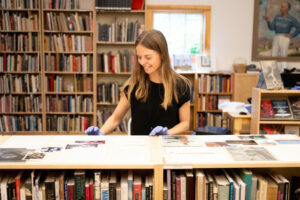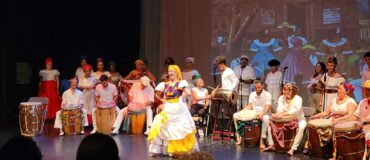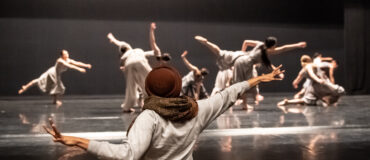By Isabel Brandt
Isabel Brandt is a 2024 Archiving and Preservation Fellow with Dianne Walker. Read more about the Fellowships here. This is the first part of Isabel’s blog.
Aunt Dianne

The Dianne Walker Archives in process (photo courtesy of Isabel Brandt)
Dianne Walker holds many titles within her professional life. Hundreds of performance programs and newspaper articles distinguish her as “award-winning tap dancer,” “educator,” “choreographer,” and “Lady Di.” But those who know her closely call her Aunt Dianne, a title that encapsulates her care, love, and passion for the tap community. Upon meeting Dianne on my first day of work as an Archiving and Preservation Fellow, I immediately understood why she holds such an affectionate title. I was welcomed like an old friend and regarded as family. On day one, it was clear to me that this project would surpass any ordinary archives project. Since the beginning, my days with Dianne have been filled with vibrant stories, tap history lessons, and visions for the future of the discipline. And at the same time, I’ve witnessed the story of her career unfold through the items of her collection.

Bottom left to right: Dormeshia, Raasahan Bouroughs, Cyd Glover; Top left to right: Duane Jones, Dianne Walker, Derick K. Grant.
Rome, Italy, 1984 (photo courtesy of Dianne Walker)
The ultimate goal for this Fellowship project is to prepare Dianne’s collection for future donation to a repository. The collection encapsulates her extensive career as a tap dancer, educator, and choreographer. Spanning decades, the collection includes approximately 40 boxes of performance programs, photographs, newspaper clippings, teaching materials, performance videos, and much more. Dianne’s collection was gathered from her basement, compiled in boxes, and introduced to me in its most natural form: without order.

Dianne Walker (center) performing with the Mildred Kennedy School of Dance – Boston, MA, 1960. (photo courtesy of Dianne Walker)
To start, I needed to determine what exactly comprised the collection. To assess the content and extent of the collection, I began sifting through each box and roughly categorizing each item. By doing so, I was able to identify the type, content, and condition of the materials in the collection. Through this assessment, I considered a system of arrangement that would allow for a box and folder-level inventory. I established 15 loose categories to physically sort the materials by item type, such as newspaper clippings or contracts. After the initial physical sorting, I established a box, or multiple boxes, for each category to house the materials and outline the inventory. To develop a comprehensive inventory, I used a spreadsheet to note the content, context, and extent of each box while adding dates and connecting related entities. At this point, every item of her paper materials is accounted for and locatable with a unique ID number.

The Dianne Walker Archives in process (photo courtesy of Isabel Brandt)
While this process seems very systematic, straightforward even, the work was more nuanced than I originally thought. In arranging the materials, I have been exploring the appropriate level of detail needed, how to determine the relevance of each item, and ways to integrate Dianne’s visions for her archives right from the outset. Dianne and I have remained in conversation about how she envisions her archives, how she hopes people will engage with the collection, and the types of narratives she hopes will shine through. Through these discussions, I’ve come to understand that it is important to Dianne that her archives not only reflect her own career but also honor the legacy of her mentors and educate future generations about this history. So, while I continue to arrange and describe the archival material, I must be creative and collaborative in highlighting the narratives that are significant to Dianne and essential to her history.
Header image: Left to right: Bernard Manners, Dianne Walker, Melvin Washington, Ivery Wheeler backstage for the production of Black and Blue – Théâtre du Châtelet, Paris, France, 1985 (photo courtesy of Dianne Walker)

Isabel Brandt is currently pursuing a Master’s Degree in Library and Information Science at Pratt Institute with a focus in archival studies. She received her BFA in Dance from The Ohio State University through which she pursued several research projects exploring the process of dance archiving and reconstruction. As an Undergraduate Library Research Fellow, Isabel conducted archival research and created a guide to unprocessed dance scores in the Dance Notation Bureau Collection to explore digital librarianship with dance notation. In 2022, she presented her research abroad to an international community of dance archivists and researchers at the conferences of the International Council of Traditional Music (ICTM) and the International Council of Kinetography Laban (ICKL). As an Archives and Audience Engagement intern with Jacob’s Pillow Dance Festival, Isabel furthered her expertise in archival reference, exhibition development, finding aid cataloging, and archival processing. Isabel is drawn to the unique, collaborative, and creative nature of dance archiving and is excited to explore how the archivist role can center artistic voice and identity.
Photo credit: Christopher Duggan
____
We accept submissions on topics relevant to the field: advocacy, artistic issues, arts policy, community building, development, employment, engagement, touring, and other topics that deal with the business of dance. We cannot publish criticism, single-company season announcements, and single-company or single artist profiles. Additionally, we welcome feedback on articles. If you have a topic that you would like to see addressed or feedback, please contact communications@danceusa.org.
Disclaimer: Opinions expressed in guest posts do not necessarily represent the viewpoints of Dance/USA.





